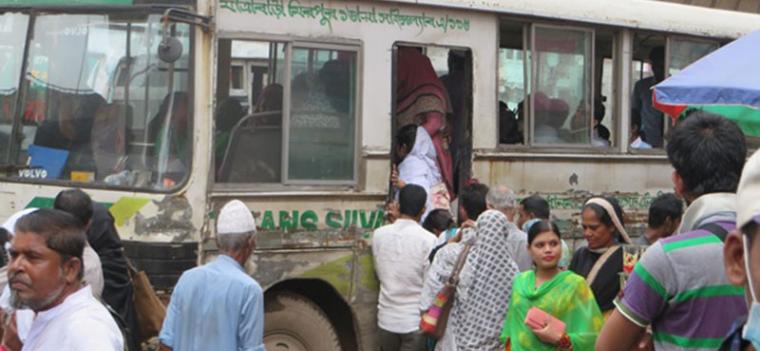News
- Building on the World Bank’s work on social inclusion, ESMAP provided funding for technical assistance that allowed officials in Dhaka to design a more inclusive transportation system
- Women groups will benefit from comparable levels of transportation accessibility
- Integrating gender considerations within analytics and ICT systems provide for smarter and more inclusive energy and transport planning
Social inclusion has increasingly become an important topic within the energy sector. Ultimately, people do not demand energy, but the services that it enables: warm homes, adequate light to study at night, go to work. Gender dimensions—such as improved access to services and benefits, and reduced exposure to risks—are gradually being recognized as integral elements for effective policy making and project design. The World Bank’s Energy Sector Management Assistance Program (ESMAP) has played a pivotal role in ensuring that gender issues move beyond advocacy and have a tangible impact on project design and outcomes. ESMAP has invested in building a foundation of knowledge from online tools, briefing notes, studies, and training resources, while also providing practical technical support to project teams during design and implementation. Through the AFREA and ASTAE Gender and Energy programs, more than 20 project teams have integrated gender into project design or policy dialogue. ESMAP is continuing to support the integration of gender across all regions and energy topics.
The Open Transport Development and Integration of ICT and Transport is one such example, where the inclusion of gender helped make an urban mobility project more sustainable and efficient for all, by incorporating the unique needs of women in the project design. The USD$125,000 project offered technical assistance to the government agency in charge of urban transport planning in Dhaka, Bangladesh to assist policy makers in visualizing land use and transport accessibility. Using information and communications technology (ICT), the pilot exercise analyzed how different sections within one metropolitan area compare in terms of accessibility of urban residents, particularly women, to jobs and urban services.
The accessibility planning included analyzing how future development of urban transport infrastructure, such as a Metro Rapid Transit (MRT) and Bus Rapid Transit (BRT) systems, may enhance or hinder accessibility. Prior research suggests that women are far less likely to use the existing transportation network due to the threat of harassment and abuse. Instead women choose to use alternative modes of transport, such as private cars or rickshaw, while women on lower incomes have little option but to walk. Based on these restrictions, and due to their complex travel needs—responsibilities for household tasks, such as arranging childcare and running errands—women travel at significantly lower speeds. The analysis considered a travel speed of half that used for the base scenario, in order to represent the disadvantage and reduced mobility that women traveling in Dhaka experience. Incorporating the analysis on social inclusion, planners were provided with analysis tools and training to understand the potential of different options for MRT and BRT lines in significantly narrowing current public transport accessibility inequalities. Women, especially, will benefit from comparable levels of accessibility along the alignments of planned new routes.
The project utilized cutting-edge open data and accessibility planning tools and built upon existing World Bank supported analytical work and tools developed in East Asia and Latin America that employed land use transport accessibility as a metric to support the evaluation of a city’s existing transport system. Data and knowledge generated from the analysis was shared with key stakeholders, as well as the general public, to support training activities for government officials, public transport operators, and city planners. Policy recommendations were created and lessons learned for successful replication were put together to help Dhaka and other cities to integrate accessibility planning into their urban and transport planning process.
The project is in line with other ESMAP and World Bank efforts to expand social inclusion within the energy sector. In April 2016, the ESMAP-funded project in China, Learning from Best International Practice in Smart Transport, released a final report "Achieving Energy Savings by Intelligent Transportation Systems Investments in the Context of Smart Cities." The report established an analytical framework to understand smart transport investments, including characteristics and conceptual models for successful implementation. This framework provides a practical way for analyzing gender impact potentials of smart transport solutions and for mainstreaming gender into smart transport projects.
In parallel, the study "Gender Impacts of ITS," funded by the World Bank administered trust fund Umbrella Facility for Gender Equality (UFGE), was conducted in Wuhan and Urumqi as pilot efforts to mainstream gender into the planning, design, operation, and evaluation of Intelligent Transportation System (ITS) projects. ITS utilize information and ICT to make more efficient use of existing transport infrastructure with the aim of improving transport services and reducing congestion, accidents, and air pollution. Gender analysis was carried out and found different travel characteristics and preferences of women. The study also confirmed the potential positive impacts ITS projects have on women.
Social inclusion is central to ending extreme poverty and fostering shared prosperity. It will continue to be an important area of focus for ESMAP, and the World Bank as a whole, in the future. As evidenced in Dhaka, when gender analysis and social inclusion are considered within energy sector projects, visibility and access to assets are tremendously increased for previously marginalized groups.
Learn more about the ESMAP Gender | Social Inclusion in the Energy Sector
